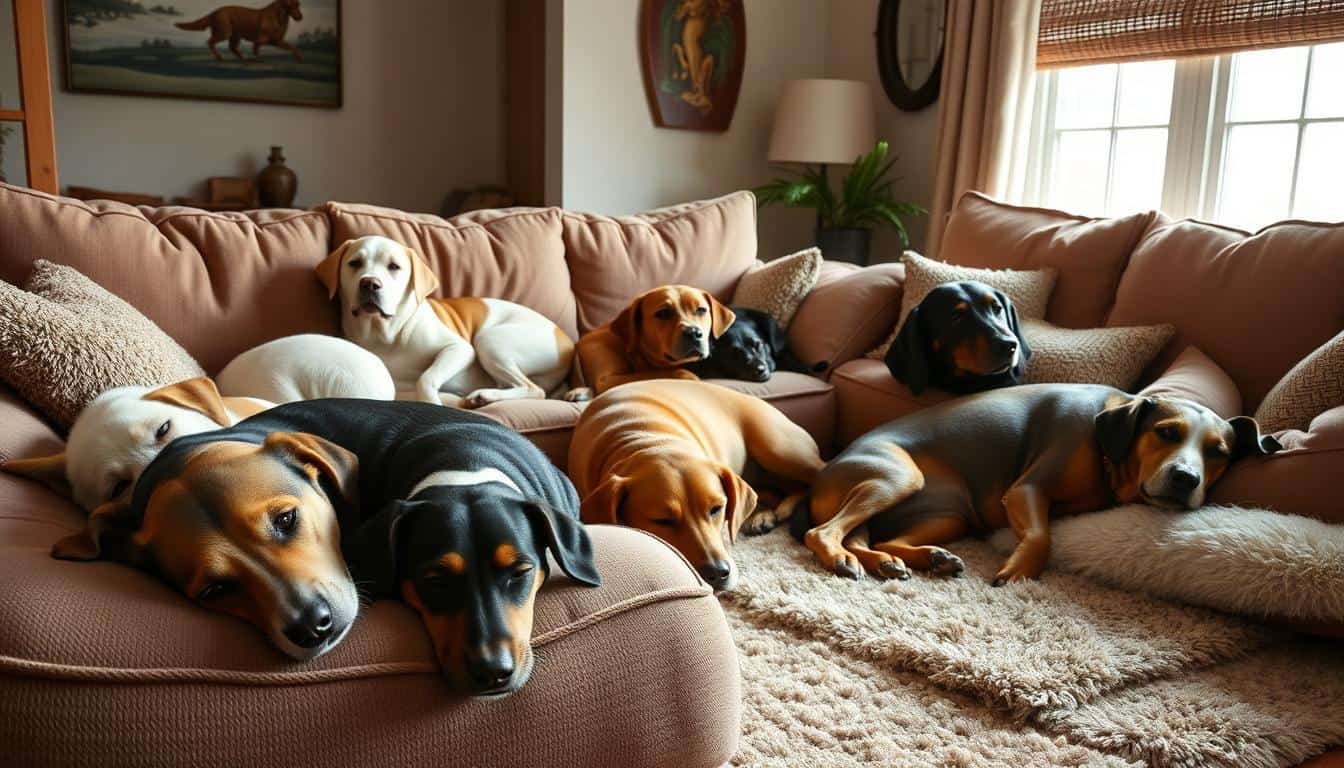Ever dreamed of a dog that fits your relaxed lifestyle? You’re not alone. Many pet owners want low energy dogs. These dogs are loyal, laidback, and love to be by your side.
In this guide, we’ll explore low energy dog breeds. We’ll look at their unique traits and help you find the perfect calm companion for your family.
I’ve always loved dogs, and my own low energy pup, Rudy, has shown me the true meaning of “man’s best friend.” Rudy is a gentle giant who loves to be by my side. He reminds me that sometimes, the best companions are those who enjoy simple things in life.
Low energy dogs bring peace and tranquility to our daily routines. They are content with just being there, without needing constant activity or attention.
- Understanding Low Energy Dogs
- Signs of Low Energy in Dogs
- Reasons Why Dogs May Have Low Energy
- Choosing the Right Low Energy Breed
- Creating a Comfortable Home Environment
- Diet and Nutrition for Low Energy Dogs
- Exercise Needs for Low Energy Dogs
- Health Monitoring and Veterinary Visits
- Enrichment Activities for Low Energy Dogs
- FAQ:
- What is the most low energy dog?
- What's the best dog for a lazy person?
- What is the least stressful dog?
- What dog is most shy?
- What are the characteristics of low energy dogs?
- What are some popular breeds of low energy dogs?
- How can I tell if a dog has low energy?
- How do I choose the right low energy dog breed for my lifestyle?
- How much exercise do low energy dogs need?
- What are the dietary and nutritional requirements for low energy dogs?
Understanding Low Energy Dogs
Some dogs are naturally laid-back and have lower energy levels. These “couch potato dogs” are great for apartment living or those who want a calm pet. But what makes a dog low energy, and which breeds are the calmest?
What Defines a Low Energy Dog?
Low energy dogs are more relaxed and less active than high-energy dogs. They enjoy shorter walks and less playtime. They love to lounge around the house and save energy for important moments with their owners.
Common Breeds with Lower Energy Levels
- Bulldog: Known for their wrinkly faces and stocky build, Bulldogs are the epitome of the lazy pup. These couch potato dogs are often content with short bursts of activity followed by extended nap sessions.
- Cavalier King Charles Spaniel: Despite their small stature, Cavalier King Charles Spaniels are surprisingly low-energy dogs. They thrive on affection and enjoy cuddling up with their owners.
- Greyhound: Contrary to their athletic build, Greyhounds are surprisingly laid-back when not racing. They make excellent apartment-friendly companions, content with short walks and plenty of lounging time.
These are just a few examples of breeds with lower energy levels. Knowing about low energy dogs helps find the right pet for your lifestyle.
Signs of Low Energy in Dogs
Knowing the signs of low energy in dogs is key when looking for a sedentary pet. These signs help you see if a dog fits your lifestyle. Let’s look at the behaviors and physical signs that show a dog has less energy.
Behavioral Indicators
Behavior tells a lot about a dog’s energy. Sedentary pooches often show certain traits:
- They nap or lounge more than they play
- They don’t want to run or jump
- They like to watch rather than explore
- They get tired or bored quickly during play
Physical Signs to Look For
Physical traits also show if a dog has low energy. Some signs include:
- They move slowly and are calm
- They have a round body, not a lean one
- They breathe and heart rate are slow, even when active
- They have less muscle and gain weight easily
Knowing these signs helps you choose the right dog for your lifestyle. It ensures you find a dog that matches your energy level.
“The perfect dog for a couch potato is one that’s content to snuggle up next to you and watch Netflix all day.”
Reasons Why Dogs May Have Low Energy
Understanding why indoor companions and lap dogs have low energy is key. Age, health, lifestyle, and environment all play a role. These factors shape a dog’s energy levels.
Age Factors
Dogs’ energy levels change as they get older. Puppies are full of energy and playfulness. Senior dogs are more relaxed and calm. This change is a natural part of their life cycle.
Health Issues
Some health problems can make dogs feel tired. Issues like thyroid disorders, anemia, and joint problems can affect their energy. Regular vet visits and quick action on health issues are vital for their well-being.
Lifestyle and Environment
A dog’s lifestyle and environment also impact their energy. Lap dogs and indoor companions may be less active than outdoor dogs. A sedentary home or lack of mental stimulation can make a dog feel tired.
Knowing what affects a dog’s energy helps you care for them better. You can address the reasons behind their low energy and support their health and happiness.
Choosing the Right Low Energy Breed
Finding the perfect dog can be easier with a low energy breed. These dogs are calm and laidback, making great pets. But, picking the right breed for you and your home is key.
Popular Low Energy Breeds
Popular breeds like the Bulldog, Cavalier King Charles Spaniel, and Greyhound are great choices. They are calm and don’t need a lot of exercise. This makes them ideal for apartments or homes with small spaces.
- Bulldog: Known for being loyal, gentle, and loving, Bulldogs love to relax at home. They don’t need a lot of exercise.
- Cavalier King Charles Spaniel: These dogs are loyal and loving. They enjoy some exercise but also love to chill at home.
- Greyhound: Despite their speed, Greyhounds are actually very laidback. They like short activities and then lots of rest.
Considerations for Potential Owners
Choosing a low energy dog means thinking about your lifestyle and home. These dogs need attention, mental play, and a safe place to live. They may not need as much exercise, but they still need care.
| Consideration | Importance |
|---|---|
| Space Needs | Even though they need less space, low energy dogs still need room to move around. |
| Activity Level | These dogs need some exercise and mental play to stay healthy and happy. |
| Grooming Requirements | Some breeds, like the Bulldog, need regular grooming to stay clean and healthy. |
Knowing what low energy dogs need helps you choose the best one. This way, you can give your new pet the best home.
Creating a Comfortable Home Environment
Creating a cozy home for low energy dogs is key. These “apartment-friendly dogs” and “indoor companions” need a calm space to thrive. They do best in a peaceful, relaxed setting.
Space Needs for Low Energy Dogs
Low energy dogs, like Pugs and French Bulldogs, don’t need big spaces. They love cozy, enclosed areas that make them feel safe. Plush dog beds, cozy blankets, and soft furnishings make great resting spots for them.
Ideal Living Conditions
To make your low energy dog’s home perfect, aim for a peaceful, low-stimulation space. Avoid loud noises, bright lights, and too much activity. Instead, use soothing music, soft lighting, and a calm routine to keep them relaxed.
| Ideal Features for Low Energy Dogs | Benefits |
|---|---|
| Comfortable, padded bedding | Supports relaxation and rest |
| Quiet, low-stimulation environment | Reduces stress and anxiety |
| Puzzle toys and interactive feeders | Provide mental stimulation without excessive physical activity |
By making your home cozy and peaceful, your “apartment-friendly dogs” will feel right at home. They’ll meet their needs as low-energy companions.

Diet and Nutrition for Low Energy Dogs
As a pet owner, making sure your dog eats well is key. Low energy dogs need special food to stay healthy and happy. Let’s look at what they need and find the best food for them.
Key Nutrients for Energy
For your dog to feel great, give them food full of important nutrients:
- Protein – Good proteins help muscles and give energy.
- Healthy Fats – Omega-3 and omega-6 fatty acids keep their coat and skin healthy and give energy.
- Carbohydrates – Whole grains and veggies give lasting energy without making blood sugar go up too fast.
- Vitamins and Minerals – A mix of vitamins and minerals like iron, zinc, and B-complex vitamins keeps energy up and health good.
Recommended Dog Foods
Choose dog food made for low energy dogs. Here are some great choices:
| Brand | Formula | Key Features |
|---|---|---|
| Purina ONE | Sensitive Skin & Stomach | High-quality protein, omega-6 fatty acids, and easy-to-digest ingredients. |
| Hill’s Science Diet | Adult Sensitive Stomach & Skin | Prebiotic fiber, vitamin E, and omega-6 fatty acids for skin and digestion. |
| Blue Buffalo | Basics Limited Ingredient Diet | Single protein source, whole grains, and essential vitamins and minerals. |
Feeding your low energy dog the right food helps them stay healthy, have steady energy, and enjoy their relaxed life.
Exercise Needs for Low Energy Dogs
Even though couch potato dogs and sedentary pooches love to relax, they need regular exercise. The right balance between activity and rest is vital. This helps them stay healthy and happy.
Importance of Moderate Exercise
Low energy dogs need to move to keep their muscles and heart healthy. But, they don’t need as much exercise as high-energy dogs. Short, easy walks are usually enough for them.
Fun Indoor Activities
For dogs who prefer staying indoors, there are fun, easy activities. Here are some ideas to keep your sedentary pooch engaged:
- Scent work games: Hide treats around the house and encourage your dog to use their nose to sniff them out.
- Puzzle toys: Interactive puzzles and food-dispensing toys can provide mental stimulation and satisfy your dog’s natural foraging instincts.
- Gentle training: Teach your dog new tricks or reinforce basic commands, rewarding them with praise and treats.
- Indoor obstacle courses: Set up a simple agility course using household items like cardboard boxes or pool noodles.
Being consistent is important when exercising low energy dogs. Make a schedule that is suitable for your dog and you. This ensures they get enough physical and mental stimulation for a happy life.

Health Monitoring and Veterinary Visits
Keeping your low energy or calm dog healthy is very important. Regular vet visits and care help them stay happy and well. This is key for their whole life.
Regular Check-ups Importance
Vet visits help check your dog’s health and catch problems early. Your vet can give the right treatment or care. These visits should happen at least once a year. Your vet might suggest more often if needed.
Vaccinations and Health Screenings
Vaccines are vital for your dog’s health. They protect against diseases like rabies and distemper. Your vet might also suggest tests like bloodwork or X-rays to check your dog’s health.
By focusing on your dog’s vet care, you help them live a long, happy life. They can keep enjoying their calm nature for many years.
“Preventive care is the key to keeping low energy dogs healthy and thriving.”
Enrichment Activities for Low Energy Dogs
As a low energy dog owner, you might wonder how to keep your calm dog engaged. The answer is in enrichment activities that challenge their minds gently. These activities include brain games and relaxed bonding exercises. They help keep your dog’s mind sharp and happy.
Brain Games and Puzzles
Low energy dogs love mental challenges, and puzzle toys are perfect for this. They can solve puzzles to get treats or sniff out food in snuffle mats. These games keep them busy and happy without needing lots of exercise.
Bonding Through Relaxed Activities
Low maintenance pets also enjoy calm bonding moments with their owners. Try gentle grooming, massage, or just cuddling on the couch. These activities strengthen your bond and help your dog relax. The goal is to spend quality time together, not to exhaust them with intense play.
FAQ:
What is the most low energy dog?
The most low energy dog breed is often the Bulldog. Known for their laid-back nature, they prefer lounging to intense activity. Other low energy dogs include the Basset Hound and the Shih Tzu. These breeds thrive in calmer environments and require minimal exercise, making them ideal companions for relaxed households.
What’s the best dog for a lazy person?
The best dog for a lazy person would be a breed known for its calm demeanor and low exercise needs. Low energy dogs like the Bulldog, Basset Hound, and Shih Tzu require minimal physical activity and are content with shorter walks. These breeds make excellent companions for those seeking a more relaxed lifestyle.
What is the least stressful dog?
The least stressful dogs are typically those with a calm and adaptable temperament. Low energy dogs like the Cavalier King Charles Spaniel, Shih Tzu, and Basset Hound are known for their relaxed nature and minimal anxiety. These breeds are content with less stimulation and make excellent companions for peaceful environments.
What dog is most shy?
The most shy dogs are often those that are naturally reserved or sensitive. Low energy dogs like the Basenji and the Shiba Inu tend to be more cautious around strangers and new situations. While they may be timid, these breeds can form strong, loyal bonds with their owners once they feel secure.
What are the characteristics of low energy dogs?
Low energy dogs are calm and laidback. They like to relax and nap more than play hard. They don’t need a lot of exercise.
What are some popular breeds of low energy dogs?
Bulldogs, Cavalier King Charles Spaniels, and Greyhounds are known for being low energy. French Bulldogs, Pugs, and Basset Hounds are also good choices. They’re great for people who want a calm pet.
How can I tell if a dog has low energy?
Low energy dogs sleep a lot and don’t like to play hard. They move slowly and seem calm. This is different from high-energy dogs.
How do I choose the right low energy dog breed for my lifestyle?
Think about your home, activity level, and time for your pet. Look at the breed’s needs, like exercise and grooming. This helps match the dog to your life.
How much exercise do low energy dogs need?
They need some exercise, but it should be gentle. Walks, playtime, and brain games are good. This keeps them healthy without exhausting them.
What are the dietary and nutritional requirements for low energy dogs?
Low energy dogs need a balanced diet. They might not need as many calories as active dogs. But, they still need good food with proteins, fats, and vitamins.
Share your thoughts in the comments below! If you enjoyed this post, consider subscribing to our newsletter for more pet tips, stories and blogs!

